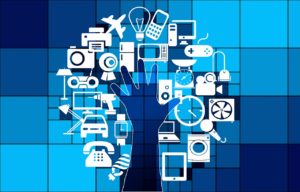 Imagine a world in which products are notifying the consumers of when maintenance is due and prospect customers are reached directly with advertising that matches their already established trends, likes, preferences, and purchasing history, ensuring a 100% click-through rate.
Imagine a world in which products are notifying the consumers of when maintenance is due and prospect customers are reached directly with advertising that matches their already established trends, likes, preferences, and purchasing history, ensuring a 100% click-through rate.
This world is now. And the reality is known as the Internet of Things (IoT). In short, the Internet of Things is everyday objects connected to Wi-Fi that communicate with each other in an effort to make our lives more streamlined.
This is not a new idea. In 2008, the number of objects connected to the internet outnumbered the number of humans on Earth. From wearable devices that track our sleep and physical activity levels to connections that allow you to control your home functions remotely. It’s clear the movement in IT is forward and the method is connectivity. We already see the Internet of Things on the front-lines of the marketplace. Disney collects biometrics data to enter the park and issues out room keys that act as credit cards in the Disney universe. Automobiles are now built with sensors that drive and park themselves, collect data on wear and tear, driver comfort, and driver security. Transportation systems are built to read current route progress and report arrival times and anticipated delays to passengers and destinations. Even healthcare systems that utilize the IoT to collect patient information remotely in a steady stream and relay health status to physicians, eliminating the need for constant human monitoring. Starbucks is leading the way, announcing that next year it will increase its use of Clover Smart Coffee Makers in its stores. Clover is a cloud-based system that tracks customer preferences, storing drink recipes thus ensuring coffee perfection with every order. Even our homes are now smart. We have thermostats that self-adjust when data sent from your biometric bracelet indicates that you are now awake. Lights that turn on when your car communicates that you are almost home. And lights that flash when the smoke detector is communicating a potential fire. Now you can watch your home when you are not even home, courtesy of Dropcam. A home monitoring device that allows you to see in real-time what’s happening when you are away, outfitted with cloud-based recording of the day-to-day happenings and two-way communication to allow you to talk to the people and pets in your house while you are away.
That’s a lot of data collection.
It is estimated that by 2015, there will be 15 billion smart devices, and by 2020 predictions believe that number will be closer to 75-200 billion. Check out this infographic, courtesy of Intel, on the growth of the Internet of Things. With the influx of data collection we are now facing an abundance of information about the world around us, interactions with our products and our customers, and predictable metrics in consumer behavior. Talk about disruption on the front-lines of industries across the line. The way the marketplace communicates with consumers is changing in a fast way.
In his article in Forbes, Howard Baldwin points out that having data coming out of our ears doesn’t necessarily mean the data is automatically useful. Beyond capturing, storing, and managing data there is the challenge of using the data in a meaningful way. After all, data is only as good as the question you are asking. Problem is, few companies really know the right questions to ask of their data.
Computers are built for detail. They do analytics. It’s their “thing”. But it takes ingenuity, mental flexibility, and imagination to transform the detail into something meaningful, something you can take to the bank. You can put sensors in your cash register, in your light bulbs, thermostats, your wristbands, and even in the car you build, but if you aren’t asking the right questions those sensors are nothing more than bling and whistles.
Authored by Leah, a member of the Research Team at Mindspot Research, a division of Mindspot, Inc., Headquartered in Orlando, Florida.


